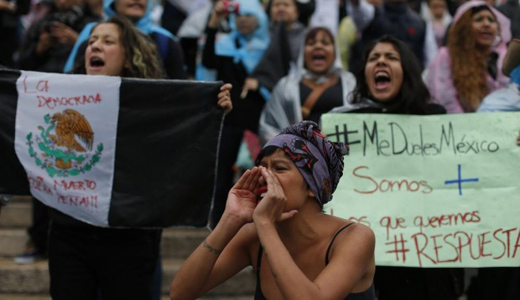
Thursday, Nov. 20 is normally celebrated as the anniversary of the beginning of the Mexican Revolution of 1910 – 1920, which overthrew dictator Porfirio Diaz, killed up to two million Mexicans and established the outlines of modern Mexican state institutions. But major public ceremonies were cancelled as the country continues to be rocked by massive protests demanding the return of 43 teachers’ training college students who were kidnapped by corrupt police on the night of Sept. 26 and have not been seen since.
The teachers from the school in Ayotzinapa, in the southern state of Guerrero, had gone to the nearby city of Iguala to raise funds to go to Mexico City for protests on the anniversary of the 1968 Tlatelolco massacre. For their return trip, the unarmed students commandeered three buses. These were then stopped by police who shot three of the students and three bystanders. Some escaped, but 43 were allegedly handed over to a criminal gang, the United Warriors (Guerreros Unidos). The Mexican federal government claims that this gang then killed them all, dismembered and burned their bodies, and threw the remains into the nearby San Juan River. The government has blamed the municipal president of Iguala, José Luis Abarca, and his wife, Maria de los Angeles Pineda, for ordering this atrocity, and both are under arrest.
The parents and friends of the 43 are not buying the government’s line. They point out that the kidnapping of the students took place practically in front of the barracks of the 27th Battalion of the Mexican Army whose soldiers did not intervene but rather harassed the survivors. Now President Peña Nieto has promoted General Saavedra, in command of the military zone where this took place.
They also note that it took an improbably long time for officials of the state of Guerrero to react.
Guerrero state has in recent decades been the site of several armed peasant uprisings, in which students and graduates of Mexico’s “rural normal school” teacher training colleges have played a part. Elected in 2012, the current Mexican president, Enrique Peña Nieto of the Revolutionary Institutional Party (PRI) has made it his goal to make the country superlatively friendly to foreign corporate investors. Investors are supposedly demanding that the educational system as well as labor and investment laws be reformed so as to make the country more attractive to them.
On taking office, Peña Nieto ordered the arrest of the politically ambitious Elba Esther Gordillo, head of the main national teachers’ union, for corruption, and replaced her with a government sycophant. But the teachers in Guerrero and Oaxaca belong to a different, militantly left-led union branch and have been a thorn in the side of the governments of both Peña Nieto and his predecessor, Felipe Calderon. The teachers fear that educational “reforms” proposed by the federal government are going to destroy the normalista system and its unique relationship with poor rural and often indigenous communities.
There are mining interests. What is potentially one of the biggest gold mining operations in the world is the Canadian Goldcorp mining giant’s operation in the municipio (roughly, county) of Eduardo Neri, roughly halfway between Iguala and the Guerrero capital, Chilpancingo. There has been a tense relationship between Goldcorp and local farmers.
Then there is the army, mobilized by President Calderon to fight drug cartels, and having major U.S. material support. Since the Cold War, the army has had a mission of subversive-hunting. In 1961, soldiers and police kidnapped and massacred peasant leader Ruben Jaramillo, who had ridden with the great Emiliano Zapata in his youth, and his entire family, in Morelos state just north of Guerrero. Jaramillo’s crime was to have defended local poor farmers’ land rights (he also had ties to the Mexican Communist Party). Nobody was ever prosecuted for the murder.
Then came the events of 1968 and others. In June of this year, the army was implicated in the massacre of 22 prisoners in Tlatlaya, State of Mexico. These were young men arrested in conjunction with the government’s anti-drug efforts, but apparently they were gunned down while unarmed, and then weapons were planted on them to make it look as if they were killed in a firefight. People going to the Nov. 20 protests in Mexico City have reported harassment by military units, including the 27th Battalion.
Then there is Peña Nieto himself, who, when governor of the large and important state of Mexico, was widely blamed for a shocking incident in the town of Atenco in 2006 when authorities killed two people and beat and raped many more while trying to put down a protest by flower vendors and opponents of the expansion of the Mexico City airport.
So to the existing slogan of the protesters, “vivos se los llevaron, vivos los queremos” (they were taken away alive, we want them back alive”) has been added the slogan “Fue el estado” (it was the state).
This and a growing corruption scandal have created a challenge to the Mexican state unprecedented in recent times.
The Nov. 20 protests were huge and extended beyond Mexico to cities around the world, including several in the United States. More protests are scheduled for Dec. 3.
Photo: Demonstrator shouts for the return of the missing 43. Dario-Lopez Mills/AP












Comments